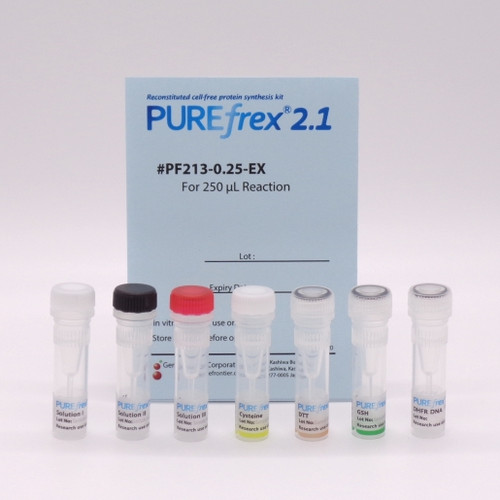
PUREfrex® 2.0 reconstituted coupled transcription/translation system is a new and improved version of PUREfrex® 1.0 that debuted in 2011. By improving the purification process for components of PUREfrex® 2.0 RNase, β-galactosidase and LPS contamination has been reduced, the latter to around 0.1EU/µL of reaction mixture. This, together with a newly optimized composition has boosted protein yield 2-10 times compared to PUREfrex® 1.0. Further, all proteinaceous components of PUREfrex® 2.0 are free of fusion tags, allowing users the freedom to incorporate any chosen tag for protein purification/detection.
New tester format available!PUREfrex® 2.0 mini (#GFK-PF201-0.1-EX, size: 100ul) is a mini size kit available to evaluate if your protein can actually be synthesized with PureFrex, allowing you the opportunity to troubleshoot and optimize your template with a lower volume. Common primers are included in the kit so you do not need to acquire them separately. PUREfrex® 2.0 mini comes with “T7Pro-SD primer” necessary for preparing template DNA using PCR and “RNase-free water” which is used for preparing the reaction solution. T7Pro-SD primer is a common primer to all proteins, including the essential T7 promoter and SD sequence in the 5’UTR of template DNA and is optimized for PUREfrex®. |
For proteins whose functional conformation requires the assistance of molecular chaperones or the creation of disulfide bonds, we offer supplemental reagents that work in conjunction with PUREfrex® 2.0.
Supplements – Molecular Chaperones
These are supplements for PUREfrex® series reconstituted coupled transcription/translation systems to promote production and solubility of aggregation-prone proteins.
Supplements – Forming disulfide bonds
These are supplements for PUREfrex® series reconstituted coupled transcription/translation systems to promote synthesis of functional proteins containing disulfide bonds.
| Citations for PUREfrex 2.0 – 17 Found |
| Bordeau, Valérie; Felden, Brice. Curli synthesis and biofilm formation in enteric bacteria are controlled by a dynamic small RNA module made up of a pseudoknot assisted by an RNA chaperone. Nucleic Acids Research. 2014;42(7):4682-96. PubMed |
| Terashima, Hiroyuki; Abe-Yoshizumi, Rei; Kojima, Seiji; Homma, Michio. Cell-free synthesis of the torque-generating membrane proteins, PomA and PomB, of the Na+-driven flagellar motor in Vibrio alginolyticus. Journal Of Biochemistry. 2008;144(5):635-42. PubMed |
| Maki, Kimika; Uno, Kanako; Morita, Teppei; Aiba, Hiroji. RNA, but not protein partners, is directly responsible for translational silencing by a bacterial Hfq-binding small RNA. Proceedings Of The National Academy Of Sciences Of The United States Of America. 2008;105(30):10332-7. PubMed |
| Handa, Yoshihiro; Inaho, Noriyuki; Nameki, Nobukazu. YaeJ is a novel ribosome-associated protein in Escherichia coli that can hydrolyze peptidyl-tRNA on stalled ribosomes. Nucleic Acids Research. 2011;39(5):1739-48. PubMed |
| Uchida, Ikuo; Ishihara, Ryoko; Tanaka, Kiyoshi; Hata, Eiji; Makino, Sou-Ichi; Kanno, Toru; Hatama, Shinichi; Kishima, Masato; Akiba, Masato; Watanabe, Atsushi; Kubota, Takayuki. Salmonella enterica serotype Typhimurium DT104 ArtA-dependent modification of pertussis toxin-sensitive G proteins in the presence of [32P]NAD. Microbiology (Reading, England). 2009;155(Pt 11):3710-3718. PubMed |
| Shimizu, Yoshihiro; Ueda, Takuya. SmpB triggers GTP hydrolysis of elongation factor Tu on ribosomes by compensating for the lack of codon-anticodon interaction during trans-translation initiation. The Journal Of Biological Chemistry. 2006;281(23):15987-96. PubMed |
| Yamamoto, Hayashi; Fukui, Kenji; Takahashi, Hisashi; Kitamura, Shingo; Shiota, Takuya; Terao, Kayoko; Uchida, Mayumi; Esaki, Masatoshi; Nishikawa, Shuh-ichi; Yoshihisa, Tohru; Yamano, Koji; Endo, Toshiya. Roles of Tom70 in import of presequence-containing mitochondrial proteins. The Journal Of Biological Chemistry. 2009;284(46):31635-46. PubMed |
| Asahara, Haruichi; Chong, Shaorong. In vitro genetic reconstruction of bacterial transcription initiation by coupled synthesis and detection of RNA polymerase holoenzyme. Nucleic Acids Research. 2010;38(13):e141. PubMed |
| Sharma, Cynthia M; Darfeuille, Fabien; Plantinga, Titia H; Vogel, Jörg. A small RNA regulates multiple ABC transporter mRNAs by targeting C/A-rich elements inside and upstream of ribosome-binding sites. Genes & Development. 2007;21(21):2804-17. PubMed |
| Narayan, Vikram; Halada, Petr; Hernychová, Lenka; Chong, Yuh Ping; Žáková, Jitka; Hupp, Ted R; Vojtesek, Borivoj; Ball, Kathryn L. A multiprotein binding interface in an intrinsically disordered region of the tumor suppressor protein interferon regulatory factor-1. The Journal Of Biological Chemistry. 2011;286(16):14291-303. PubMed |
| Yamano, Koji; Yatsukawa, Yoh-Ichi; Esaki, Masatoshi; Hobbs, Alyson E Aiken; Jensen, Robert E; Endo, Toshiya. Tom20 and Tom22 share the common signal recognition pathway in mitochondrial protein import. The Journal Of Biological Chemistry. 2008;283(7):3799-807. PubMed |
| Yamaguchi, Toshiya; Yoshinaga, Norifumi; Yazawa, Takashi; Gen, Koichiro; Kitano, Takeshi. Cortisol is involved in temperature-dependent sex determination in the Japanese flounder. Endocrinology. 2010;151(8):3900-8. PubMed |
| Vázquez-Laslop, Nora; Klepacki, Dorota; Mulhearn, Debbie C; Ramu, Haripriya; Krasnykh, Olga; Franzblau, Scott; Mankin, Alexander S. Role of antibiotic ligand in nascent peptide-dependent ribosome stalling. Proceedings Of The National Academy Of Sciences Of The United States Of America. 2011;108(26):10496-501. PubMed |
| Ullman, Christopher G; Frigotto, Laura; Cooley, R Neil. In vitro methods for peptide display and their applications. Briefings In Functional Genomics. 2011;10(3):125-34. PubMed |
| Fukushima, Keiko; Ikehara, Yukio; Yamashita, Katsuko. Functional role played by the glycosylphosphatidylinositol anchor glycan of CD48 in interleukin-18-induced interferon-gamma production. The Journal Of Biological Chemistry. 2005;280(18):18056-62. PubMed |
| Yano, Masato; Okano, Hirotaka J; Okano, Hideyuki. Involvement of Hu and heterogeneous nuclear ribonucleoprotein K in neuronal differentiation through p21 mRNA post-transcriptional regulation. The Journal Of Biological Chemistry. 2005;280(13):12690-9. PubMed |
| Bordeau, Valérie; Felden, Brice. Curli synthesis and biofilm formation in enteric bacteria are controlled by a dynamic small RNA module made up of a pseudoknot assisted by an RNA chaperone. Nucleic Acids Research. 2014;42(7):4682-96. PubMed |





